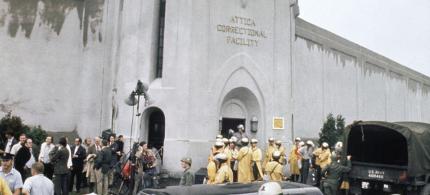By Michael Virtanen, Associated Press
New York’s attorney general has asked a state judge to release sealed documents about the 1971 riot and retaking of Attica state prison in an effort to reveal the full history of the nation’s bloodiest prison rebellion and answer the questions of families whose loved ones died there.
Attorney General Eric Schneiderman wants the court in Wyoming County to open hundreds of detailed pages about investigations into the five September days when inmates took control of the maximum-security prison in rural western New York until state troopers and guards stormed the facility and fatally shot 29 inmates and 10 hostages.
Schneiderman said it’s time to bring transparency to what he referred to as one of the state government’s darkest chapters. The sealed documents are part of a 1975 report by a special commission that examined New York’s efforts to investigate the riot and its aftermath.
“It is important, both for families directly affected and for future generations, that these historical documents be made available so the public can have a better understanding of what happened and how we can prevent future tragedies,” Schneiderman said. He noted the historical significance and the fact that all related criminal and civil litigation has ended. And after 40 years, he said, the privacy concerns can be addressed more narrowly by omitting only the names of many grand jury witnesses and some people identified in testimony.
Among those seeking the records are the Forgotten Victims of Attica, a group of prison employees who survived and relatives of those who died.
“For families that lost their father, son, brother because they were killed in D Yard, they yearn to know the truth of how their loved one died and why they died,” said Gary Morton, a lawyer representing the group, said this year. “Some of that has come out, but certainly there’s a lot more that hasn’t come out.”
In all, 11 staff and 32 inmates died – all but four shot by troopers and correction officers who fired hundreds of rounds in six minutes storming the prison’s D Yard on Sept. 13, 1971. An additional 89 men were wounded. The inmates were demanding better conditions and amnesty for the riot itself.
Known as the Meyer Commission Report for the late judge who headed the investigation, the 570-page document was divided into volumes. The first with broad findings and recommendations was released, but the others were sealed in 1981 because they contain grand jury testimony.
Published four years after the riot, the first volume said 62 inmates had been indicted for various offenses, but the grand jury investigation should continue and consider all possible crimes by authorities. The original grand jury refused to indict in four cases brought against law enforcement personnel. One trooper was later indicted on a charge of reckless endangerment in 1975.
The commission report emphasized “important omissions” in the evidence gathered by state police afterward and the possible conflict of interest with troopers investigating their fellow officers’ actions in retaking the prison. It found no intentional cover-up by prosecutors but faulted police for bad planning and failing to account for the rifles, shotguns and pistols used and bullets, slugs and buckshot fired by individual officers.
Gov. Hugh Carey effectively ended official scrutiny of the uprising in 1976 when he pardoned seven inmates and barred disciplinary action against 20 of the troopers and prison guards among the hundreds of officers who retook the prison. He also commuted the murder sentence of inmate John Hill, who was found guilty of beating guard William Quinn to death. The report concluded Quinn and three inmates were killed by prisoners.
Schiederman’s request was filed late Friday. It isn’t clear when the judge will rule.
In 2005, the state reached a $12 million settlement with survivors and families of prison staff caught in the uprising. About 150 claims were filed.
That followed a settlement for $8 million five years earlier with 502 former inmates and families of those killed or injured, who claimed they were beaten, tortured and denied medical treatment after the prison was retaken.
Audiotapes published in 2011 showed then-President Richard Nixon offering support by phone to then-Gov. Nelson Rockefeller hours after the siege ended. “You did the right thing. It’s a tragedy that these poor fellows were shot but I just want you to know that’s my view and I’ve told the troops around here that I back that right to the hilt,” he said.
While Rockefeller initially praised the work of state police sharp shooters and called the retaking “a beautiful operation” a day later, he acknowledged “a little problem” – that most hostages were killed by gunfire, not by inmates as initially believed.















